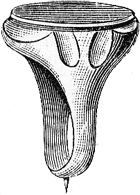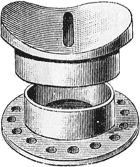
|
foreword to the online edition I. introductory II. common sharpers and their tricks III. marked cards and the manner of their employment IV. reflectors V. holdouts VI. manipulation VIII. the game of faro IX. prepared cards X. dice XI. high ball poker XII. roulette and allied games XIII. sporting houses XIV. sharps and flats
|
SHARPS AND FLATS
CHAPTER III MARKED CARDS AND THE MANNER OF THEIR EMPLOYMENT
§ G -- Cards marked whilst in playWe now arrive at the last subdivision of this branch of our subject, and perhaps the one which will prove most generally interesting, viz. the possibility of placing distinctive marks upon the cards during the course of the game. The average reader may probably be surprised to learn that such a practice has been resorted to by sharpers from time immemorial. Further, its accomplishment presents not the slightest difficulty, in fact it is the simplest thing in the world. The earliest method appears to have been that ot raising a slight burr upon the edges of the cards with an instrument provided perhaps for that purpose (?) -by Nature, to wit, the thumb-nail. This and other primitive methods alike have been superseded by others more scientific. Therefore we will not waste our time in detailing such elementary matters, but pass on to the means used at the present day. One of the simplest appliances is the 'nail prick,' quoted in the price-lists at half a dollar. This is simply a tiny piece of metal, carrying a point, which is held when in use under the thumb-nail of the right hand. With this point the cards can be pricked without observation, in positions which will indicate the suit and value. It is, however, not much used. Pricking the cards is a method chiefly employed by men who can deal 'seconds.' The sharp will prick the corners of all the aces and court cards, or as many of them as happen to fall into his hands, from time to time; and whilst dealing, he can feel the little projection caused I the prick, and hold these cards back till they could be dealt to himself. One who did this every time it came to his turn to deal must inevitably win all the money sooner or later. No sharp, however, would be insane enough to arouse suspicion in this manner. The most refined and scientific method of pricking the cards is by means of an ingenious little appliance, known as the 'poker-ring.' This is an ordinary finger ring, having attached to it upon the under side a needlepoint of about one sixty-fourth of an inch in length (fig. 1 8). In the illustration, the length of the point is exaggerated.
FIG. 18 As the cards are held in the hand, the corner of any one which it is desired to mark is simply pressed against the point with the thumb of either hand. Thus with one hand the sharp is enabled to mark any card he chooses, under the very eyes of his adversaries, and without a single suspicious movement being observable. But the greatest advance in this direction was made when the art of marking cards with shade-work was discovered. It was found that a little aniline color, taken upon the tip of the finger, could be transferred to the back of a card slightly deepening the tint in the spot to which it was applied. The color was at first derived from a piece of blue aniline pencil, carried in the pocket, and upon the point of which the finger was secretly rubbed. As far as one can ascertain, the English sharp has not progressed beyond this point in his professional knowledge. In America, however, it is otherwise. Across the water, superior intelligences soon concocted a colored paste which would answer the purpose much better. Scooping a hole in a piece of cork, the cavity was filled with the composition, and the cork was sewn inside the lower edge of the waistcoat. In this position the color was convenient to the hand. The idea thus conceived has been improved upon until one may say that this method has reached perfection in the form of appliances known as 'shading boxes.' These implements of chicanery, of which fig. 19 is an illustration, are little nickel-plated boxes, which are completely filled with the colored composition. In the centre of the lid is a slot through which the color is pressed. The finger being passed over this slot, takes up a little of the color. The base of the box is pierced around the circumference with small holes, for convenience in sewing it to the inside of the waistcoat or underneath the flap of a side pocket, as may be preferred. The boxes are generally used in pairs, one containing red composition and the other blue. With these two colors, almost every colored card can be marked. The paste for refilling the boxes is supplied separately, or, if the sharp is acquainted with its composition, he may make it for himself. Here is the recipe. FIG. 19 Olive oil, stearine, and camphor are incorporated in a melted condition with aniline of the required hue. The mixture is then poured out upon a level surface and allowed to cool. When cold it is worked up with the blade of a knife upon a sheet of white paper, to get rid of the superfluous oil. It is then ready for use. Marking placed upon cards in this way can be instantly removed by merely rubbing the card upon the table-cloth. It is worthy of note that these boxes are considered to be so good that they are not included in the catalogues of dealers in so-called 'sporting-goods.' They are kept as a secret among those who are 'in the know.' These convenient little articles, then, bring us to the end of the systems of marking. It only remains to instruct the neophyte who has followed the course of our lessons so far, in the methods of utilizing the marks when once they are placed upon the cards. Those familiar words of the great artist who said that the medium he employed in mixing his colors was 'brains,' may find an echo in the directions for playing marked cards. They must be used with intelligence or not at all. Indeed, great circumspection is requisite in utilizing the information which the marks provide. In a game of whist, for instance, a thorough-paced player would at once detect any glaring peculiarity of play resulting from knowledge surreptitiously acquired. One may know, perfectly well, which card in one's hand would win the trick, but it is not always advisable to play it. Tact and judgment, added to a thorough acquaintance with the rules of the game which is being played, are necessary adjuncts to the successful employment of any system of cheating. In a round game, when it is your turn to deal, you may read the cards as you deal them; and in this way know the hands of your opponents, or at any rate the principal cards. In a single-handed game you can remember the whole of your antagonist's cards, but with more than two players it is not advisable to attempt to commit to memory more than one hand. That, preferably, should be the hand of the 'flattest man,' the 'greatest mug,' the man who is playing highest, or your most dangerous opponent. With a little practice the top card of the pack can be read, just before it is dealt. There is plenty of time for this whilst the previous card is on its way to the table. In a game such as Poker, where the suit is of no consequence, you simply repeat to yourself the value of the card as you deal it, and from your knowledge of the game you may deduce the discards from that particular hand. Then, in giving off the 'draft' i.e. the cards to replace those which have been discarded, and which, of course, you have not seen you read the cards as they are given out. In this way you can form a tolerably accurate opinion as to what cards that hand finally contains. If your hand happens to be better, you can bet against this particular player, continually raising the stakes until all the other players are 'raised out.' That is to say, they do not feel inclined to risk so much money on their hands, and therefore they throw them down, and leave the game, for the moment, in the hands of the two highest players. A knowledge of the top card may be utilized in dealing 'seconds.' The top card, being one which you require, may be kept back until it comes to your turn either on the deal or the draft. This, however, is a very bad way of using marked cards. It is sure to be detected sooner or later, and then your only course will be to 'clear out' from the scene of your former victories. Whilst, if you confine your attention to the use of the information given by the marks, trusting to your wits rather than to the deftness of your fingers, you will not only win but 'last.' Working with shaded cards, in which the shading occupies the greater portion of the card, many of your opponents' cards can be read as they hold them in their hands; especially where they are held spread out, as is so often the case in England. Whatever may be the game, marked cards will often enable you to win where you otherwise would lose, so long as due care and judgment are exercised. For example, at Vingt-et-un, you will always know whether it is advisable to draw another card or not. You will not stand in doubt as to the card you will get. At Baccarat you will know what cards you have given the players, and what you will draw if you take one. Too many false drafts, however, are liable to create suspicion; so in this game you must be careful in your proceedings. At Loo, you will have a strong advantage, as you will always know the contents of the hand upon the table, and when to take 'miss.' In games such as 'Banker' or 'Polish Bank,' which consist of betting that you have in your hand a card (not seen) which will beat one that has been turned up, you have to contend with no uncertainty whatever. Having pursued our subject to this point, it cannot be denied that we have learnt something of great importance, viz. that among the advantages enjoyed by us in this nineteenth century, we must not overlook those embodied in the fact, that not only are marked cards articles of commerce, readily obtainable at the right places, but we have also the means of falsifying genuine cards, of any pattern, at a few minutes' notice. Even failing this, we have at our command means of marking all the cards which it is necessary to know whilst under the very noses of our antagonists. The practical philosopher -- if such exist -- whilst meditating upon the benefits accruing to mankind from civilization, should by no means forget that, in one notable instance at least -- card-playing to wit -- civilization has provided the means of eliminating from the affairs of life the undesirable and inconvenient element of chance. There is no such thing as chance, says the predestinationist; and certainly in some cases the truth is with him.
|
| « marked cards... (line and scroll work) | reflectors » |
home | introduction | book content | links | advertising | contact

